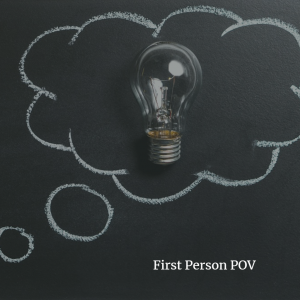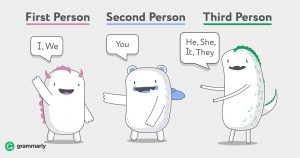Pardon the title; I couldn’t help myself. Today I want to talk about point of view, or POV. The POV is the perspective from which your story is being told. Unless you’re writing your autobiography, your POV is not your own voice. It’s generally the voice of one of your characters or a narrator.
After a brief intro to the basic kinds of POV, I’m going to focus on what to consider when deciding between the three POVs that occur most often in fiction: first person, third person omniscient, and third person limited.
POV: First, Second, Third
POV can be written in first, second, or third person.
First person uses the first-person pronouns: I and we (and me, my, us, etc.). This is, of course, common in autobiography and memoir. But it can also be used to great effect in fiction. If your narration is coming directly from the mind of your character, you’re writing in first person. You’re essentially writing someone else’s autobiography. The Hunger Games is a popular example. Everything we see in that series is directly through Katniss’s POV. We hear what she hears, see what she sees, feel what she feels. We are basically inside her head. Anything we learn about any other character has to come to us through Katniss.
Second person POV uses you. Basically instead of telling a story about someone else, you’re telling the reader a story about themselves. Think about one of those old “Choose your own adventure” books: You’re in a large, dark room. A strip of light glows near the floor to your right, and you can make out the dim form of a bookcase to your left. If you choose to walk towards the light, turn to page 3. To examine the bookcase, turn to page 4. Etc. Honestly, I’ve read very few books in the second person and I think it takes a lot of work to do well. But it can be done. It certainly adds a great sense of immediacy and inclusion to your writing. So go ahead and experiment with it!
Third person POV uses the third-person pronouns: he/she/it and they. You’re not telling the story directly through the mind of your reader but rather through a third party. Third person POVs are broken into two categories, limited and omniscient, which I’ll discuss in more detail below.
First Person
Writing in first person has a few main costs to consider. For instance, you can’t keep secrets from your reader, at least not secrets that your main character knows. You also can’t really use multiple perspectives in one book. Having two or more different “I” characters speaking in one book is liable to get confusing.

Another potential pitfall is pulling the reader out of the story to wonder how and when exactly the main character is relating this information. Is it a journal, or a conversation? Is the story happening in real time or is the main character looking back on events from years ago? You may want to address these questions if you’re writing in first person—but you don’t have to. Many books, including Hunger Games, don’t. However, answering these questions can produce some very interesting story developments. For instance, Patrick Rothfuss’s frame story in the Kingkiller Chronicles makes it very clear how and when Kvothe is relating his story—which leads to some fun speculation on the future of the series.
To choose a POV, you need to be aware of the scope of your story. If your story revolves around one person and their immediate concerns, first person is an excellent choice. First person allows you to tell a very personal, visceral story. The reader will feel like the narrator is speaking directly to them. This approach is particularly common in YA, perhaps because so much of teenage life involves learning how to connect with other people. However, if your story is going to grow beyond one person and cover region- or worldwide events, you probably want to use a third person POV.
Third Person Omniscient
Third person omniscient is an interesting POV and perhaps the most difficult of the three to do well. In omniscient, your narrator knows everything. And they are not a part of the story. Think of your third person omniscient narrator as a god. They know every detail and feeling of each character’s life, and they can tell your reader about them whenever they like. Fairy tales are typically told in third person omniscient. A lot of The Lord of the Rings I would consider to be in third person omniscient. Some books, like Robert Jordan’s Wheel of Time start out omniscient and narrow down into a limited point of view.

The benefit of omniscient is you can describe emotions and events that are happening away from the main character. You can provide background information your characters don’t know and describe reactions happening on the other side of the room.
However, the main difficulty with third person omniscient is that, if you’re not careful, it will just read as head-hopping. Head-hopping is jumping abruptly from the mind of one character to another. If you’re going to be truly omniscient, you can’t get too close inside one person’s head. The jump to another close view of someone else’s head is jarring to the reader. I think the key to writing omniscient is to keep a bit of distance between the narrator and the characters. And then, of course, you run this risk of telling instead of showing. Writing omniscient requires you to walk a very fine line.
Third Person Limited
Third person limited is probably my favorite POV and potentially the most common (I’m not sure which is used more, first or third limited. I should do some research). In a lot of ways, third person limited and first person are very similar. In third person limited, you are again following events primarily from the point of view of one person—but you are not in their head. It’s like you have a godlike narrator who can only look inside one person’s mind. Harry Potter is third person limited, Sanderson’s cosmere books, Dragonriders of Pern, etc. etc.

In third person limited, you still want to have your POV character’s life experiences and personality color your description. I talked about this in my discussion of double duty writing in description. The same scene seen through two different third-person-limited POVs should read entirely different based on the differences between the characters.
Again, in this POV you’re allowing your reader to get really close to one character. However, unlike in first person, you can have different sections be from different viewpoints. It is therefore very common in epic fantasy and other wide-ranging genres. If you have a large cast of characters who do interesting things in a variety of places, you’ll want to use third person limited. But again you need to make sure you avoid head-hopping. Don’t provide multiple characters’ limited perspectives within one scene. Whenever you want to change the POV character, you should have a scene or chapter break.
Third Limited or First?
Plenty of third person limited books only use one perspective. So why choose third person over first, in that instance?
Again, think about your intended scope and feel of the book. Even if you only want one viewpoint, third person limited lends itself to a grander feel. Writing in first person focuses the attention on one person; writing in third gives an innate sense of a larger world. You also don’t have to deal with the first person questions I listed above. In a first person story, you sort of assume that your POV character is going to live through the story, otherwise they wouldn’t be able to to finish the story. A third person limited POV character might not necessarily survive. Even though they usually do, the third person perspective adds just a little bit of uncertainty.
Third person limited also allows you a bit more leeway in your textual descriptions. I’m going to put these two images side by side, because I love the comparison. Both are showing the same information, but from a different perspective.


In third person limited, You aren’t strictly limited to exactly what’s going on in the character’s head. This makes it easier to gloss over surprises your character knows but you don’t want your reader to know quite yet. However, be careful not to stretch the limits of disbelief on this one, like in a certain book I reviewed recently. Don’t keep a character from thinking about a major plot point for an extended amount of time.
POV Consistency
Above all, when choosing a POV, you want to be consistent. You’ll probably want to choose your POV before you even start writing. Consider the scope and feel of your story, whose emotions are important, and how you want to maintain tension. If you start writing and find you want to switch to a different POV, that’s fine—but you’ll need to go back and rewrite what you’ve already finished in the same POV. And you should definitely experiment; you may find that you thought third person limited was best for your story, but it actually works better in first. Or vice versa.
Just make sure you pick one in the end. Inconsistency in POV is one of the most common writing mistakes I see. And nothing will throw your reader out of the story faster than a break in POV. So once you’ve settled on a POV for your story, stick to it.


